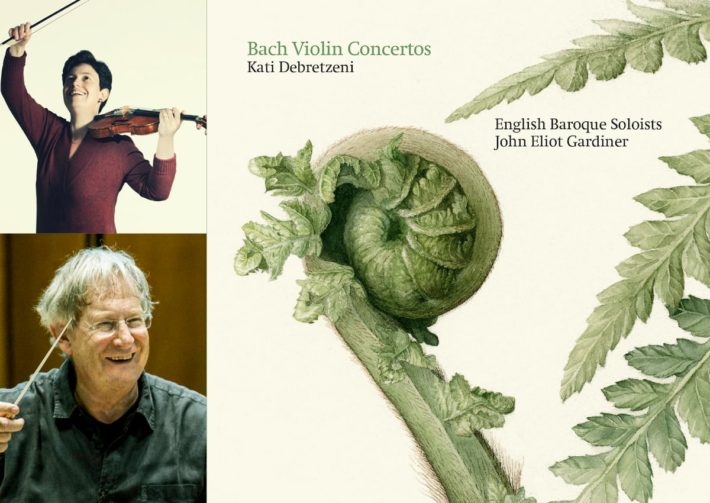Kati Debretzeni was a member of the English Baroque Soloists in 2000 when they and John Elliot Gardiner performed all of J.S. Bach’s cantatas in a single year. Arriving almost twenty years later to Bach’s violin concertos, Debretzeni and Gardiner have given us a splendid recording to mull over, whose roots are certainly in Bach’s vocal music. In a recent interview for “The Strad”, Debretzeni spoke of understanding Bach’s music through three elements: “dancing, speaking, and singing”. Each is present here, and in the proper proportions.
Take the first movement of the A minor concerto (track 1). Throughout the movement, there is a disconnect between the melodic material of the orchestra and that of the soloist, a gap that only occasionally bridged. Many groups play the introduction quite expressively, which can steal the spotlight from the violin’s material. Here, the Baroque Soloists are clearly in “speaking” mode for the introduction. There is no tempo modulation, no vibrato, no legato. They don’t sound robotic, but prosaic. When Debretzeni enters, magic happens: suddenly something is alive (0’30”). The tempos wiggle a bit more, there is vibrato — she’s singing and dancing. When the concerto’s Andante arrives, the orchestra joins Debretzeni as an equal in this more expressive mode, despite a second set of contrasting melodic materials. Gardiner and Debretzeni’s genius in this concerto is knowing when to use these different modes.
The E major violin concerto is similarly wonderful. The orchestra sounds like an entirely different group when introducing its main theme, spritely, and sharing the expression with the soloist (track 7). Those who prefer the inner movements of these two concertos on the slow side will be disappointed (tracks 2, 8), though they do pace leisurely, and the more moderate tempi allow for rubatos without loss of momentum.
In both third movements, Debretzeni departs a bit from tradition. At moments, notes stick out where they don’t feel right — Debretzeni’s approach here is different from, say, Rachel Podger, whose articulations and emphases always feel natural. Many of Debretzeni’s choices are pleasing, though, and once again bring a feeling of singing to music that risks sounding like an etude in others’ hands. Listen, for example, to Hilary Hahn’s 2007 recordings for a virtuosic but utterly unemotional rendition of these two allegros. Lest any young readers get the idea that speed is an essential element for a successful performance of Bach, compare Debretzeni also to Alice Harnoncourt, playing with her husband Nikolaus and the Concentus Musicus Wien in 1967. Harnoncourt’s rendition is among the slowest available, but it never becomes capital-R Romantic. It is full of life, and is an equal to Debretzeni’s version.
Gardiner and Debretzeni round out this album with two “reconstructed” violin concertos. The first is Wilfried Fischer’s version of the well-known D minor harpsichord concerto that was likely for violin to begin with. This is perhaps Bach’s most emotionally arresting concerto. The outer movements are played in a forceful speaking voice, and Debretzeni shows off her virtuosity to great effect, like in the final solo passage starting at 5’55” (track 10). Her stiffest competition in this concerto might be Amandine Beyer with Gli Incogniti, but Breyer is unwilling to slow the tempo in those expressive moments. The Adagio is a startlingly slow tempo for this group, but it greatly magnifies the sorrow of the music (track 11).
Debretzeni’s own, new arrangement of the lesser-known E major harpsichord concerto is the second reconstructed concerto on the album (tracks 4-6). The composition does not quite compare to the other works on the album (Bach’s fault, not the performers’), but the middle Siciliana that Debretzeni apparently admires is graceful and a nice addition. The melody feels slightly bare after Debretzeni’s removal of the embellishments (to make it more violinistic), and might benefit from some improvisational re-embellishment.
These Bach recordings are more than polished, acoustically well-balanced, and emotional: they are instructional. Listeners and musicians alike should look to this set as an insightful inspiration for a long time to come.

Bach – Violin Concertos
Kati Debretzeni – Violin
English Baroque Soloists
John Eliot Gardiner – Conductor
Soli Deo Gloria, CD 843183073221
Bach’s Violin Concertos – Recommended Comparisons
Read more classical music reviews or visit The Classic Review Amazon store
Follow Us and Comment:
Get our periodic classical music newsletter with our recent reviews, news and beginners guides.
We respect your privacy.









